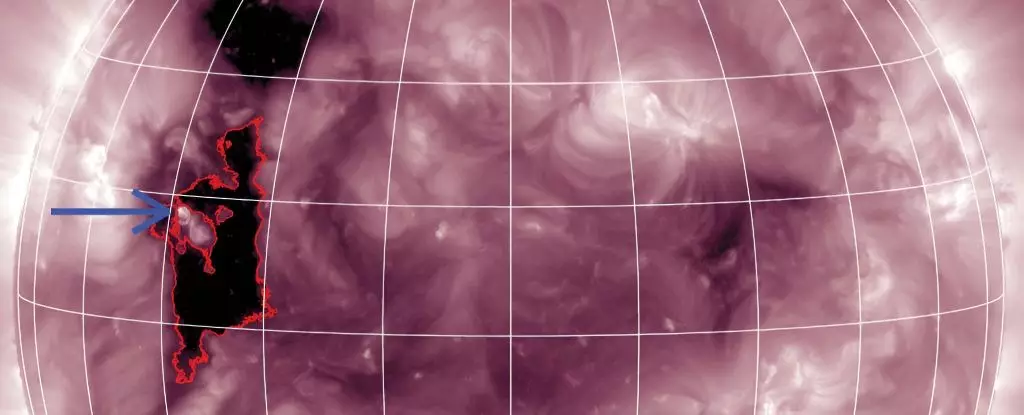In an astonishing turn of events in October 2023, astronomers witnessed an unprecedented phenomenon as the Sun unleashed an extraordinary quantity of helium-3, a rare isotope that had long eluded easy detection in our solar neighborhood. Traditionally, helium-3 exists in the solar system at a dismal ratio—approximately one ion per 2,500 helium-4 ions. However, during this remarkable solar episode, the Solar Orbiter observatory, under the collaborative aegis of ESA and NASA, captured helium-3 surge concentrations that soared to an astonishing 180,000 times greater than normal. This unexpected burst shines a light on the intricacies of the Sun’s behavior, compelling us to reevaluate existing models of solar outflows and the enigmatic nature of solar isotopes.
Coronal Holes: Gateways to Cosmic Wonders
The source of this helium-3 explosion has been traced back to a jet emanating from a coronal hole—temporary voids in the Sun’s magnetic field where plasma density diminishes. In these regions, the Sun’s exosphere becomes surprisingly less active due to weakened magnetic forces, allowing charged particles to escape with greater freedom. The specific coronal hole, identified on the Sun’s surface during October 24 and 25, provided a fortuitous setting for an exploration of solar jets and their cosmic consequences.
What’s remarkable about coronal holes is that they are often obscured and invisible to the naked eye, yet they reveal themselves vividly in ultraviolet and X-ray wavelengths—spaces where solar wind escapes at furious speeds. The implications of these sweeps of solar wind are profound. The release of lighter isotopes like helium-3 facilitates crucial inquiries into not only the composition of solar materials but also the broader understanding of the cosmic chemical processes that have unfolded since the Big Bang.
The Enigmatic Helium-3: More Than Just a Novelty
Moreover, helium-3 holds significant allure beyond its rarity. The understanding of its behaviors and distributions is central to numerous astrophysical theories regarding the formation of the universe. The discovery that solar jets can preferentially accelerate helium-3 suggests that these lighter isotopes may offer insights into solar dynamics that have yet to be fully uncovered. Astrophysicist Radoslav Bučík articulates the gravity of this observation, mentioning how the distinct charge-to-mass ratio of helium-3 enables it to be propelled at immense energies during solar events.
In addition to being scientifically intriguing, helium-3 carries potential implications for future energy resources on Earth. It is seen as a potent fuel for future fusion reactors, thus heightening the urgency for a detailed understanding of its solar origins and pathways. Understanding these unique outflows may not just account for a portion of the isotopes already present in our solar system but could also foreshadow practical applications in energy production for generations to come.
Unraveling a New Layer of Solar Mysteries
What truly sets this event apart is the atypical composition of the solar jet itself. Unlike traditional solar particle events that are typically enriched with heavier elements like iron, the outflow from this particular solar event showcased a strong presence of lighter elements such as carbon, nitrogen, silicon, and sulfur, thereby painting a broader picture of the solar chemical diversity. Such unique characteristics in the October 2023 event were strikingly rare. The infrequency of these profiles invites a paradigm shift: Are these solar compositions an exceptional occurrence or unobserved commonplace phenomena masked by weak signals?
With the Solar Orbiter’s strategic positioning—approximately halfway between the Sun and Earth—a daring opportunity presents itself. By harnessing its vantage point, we have the chance to capture the intricacies of solar behavior that were once hidden from view. This mission not only enhances our understanding of solar phenomena but could also lead to broader implications in astrophysics, including solar-climate interactions that influence life on Earth.
A Solar Event with Far-Reaching Implications
In the grander scheme of cosmic understanding, the emergence of helium-3 from solar jets is a pivotal clue that could unlock further revelations about the Sun’s dynamics and our solar system’s history. It beckons researchers to delve deeper into solar geology, further propelling the scientific narrative about the formation of elements and matter throughout the universe. The magnetic gymnastics involved in solar jets provide an onlook into not only the behavior of our Sun but also of other stellar bodies beyond our immediate neighborhood.
The helium-3 event in late October 2023 may be a stepping stone toward a comprehensive awakening to the wonders of our nearest star. As scientists continue to document and analyze these spectacular incidents, the quest to decipher the Sun’s haunting complexities is more vital than ever, opening the door to endless possibilities for innovation and exploration.


Leave a Reply